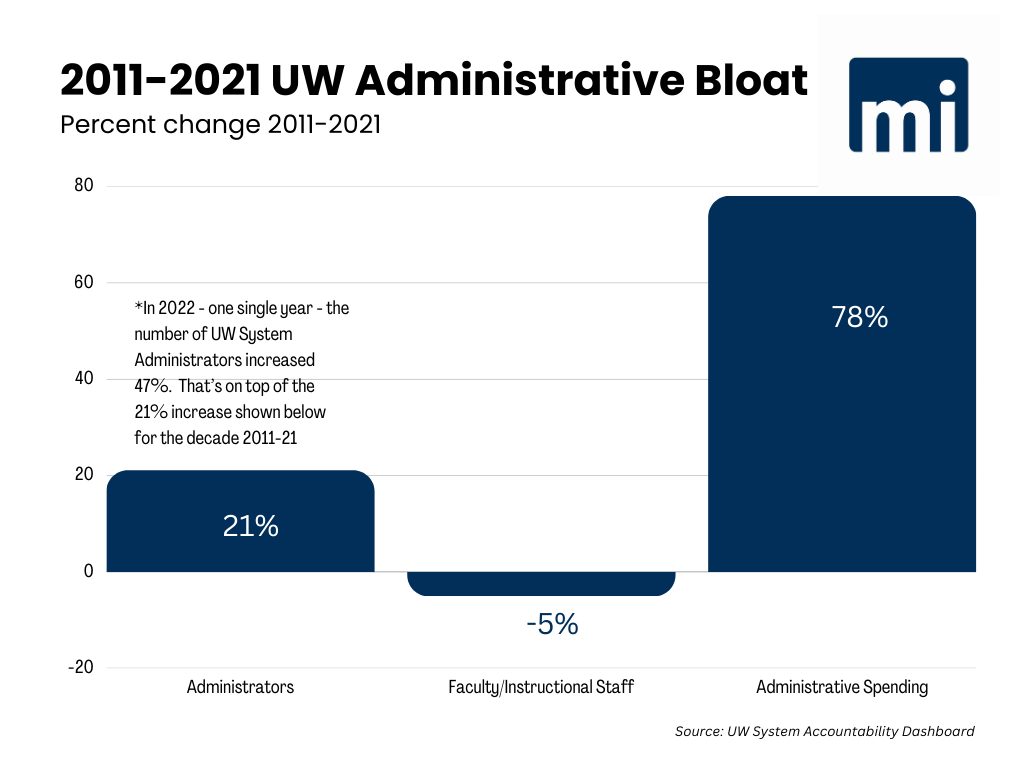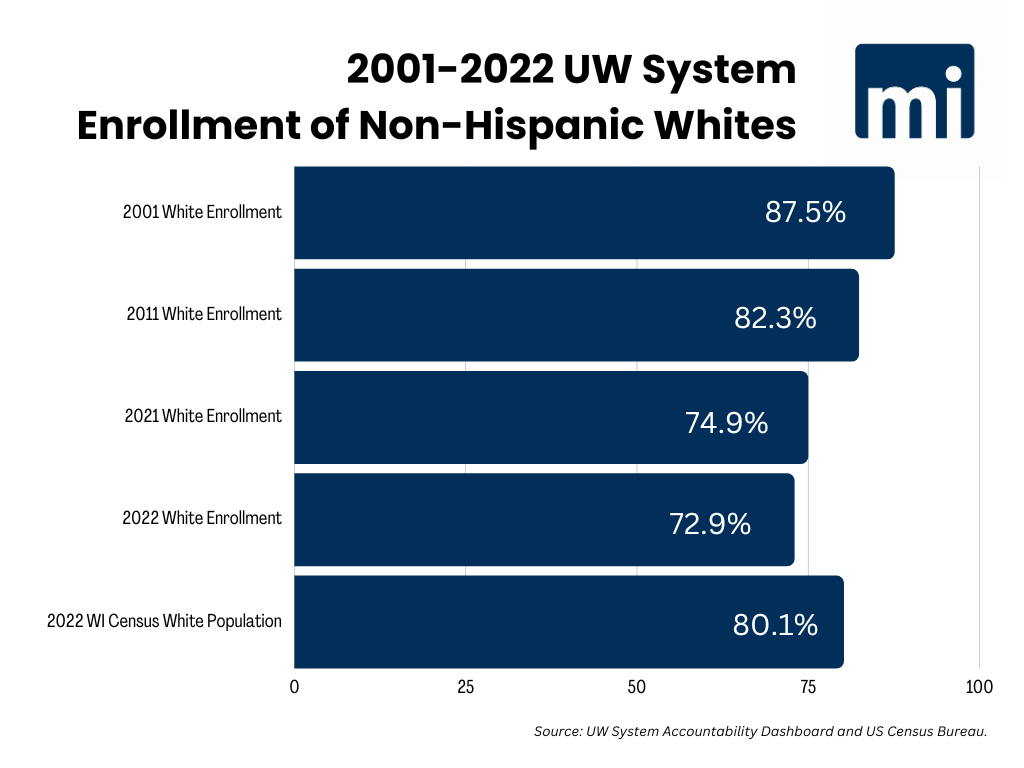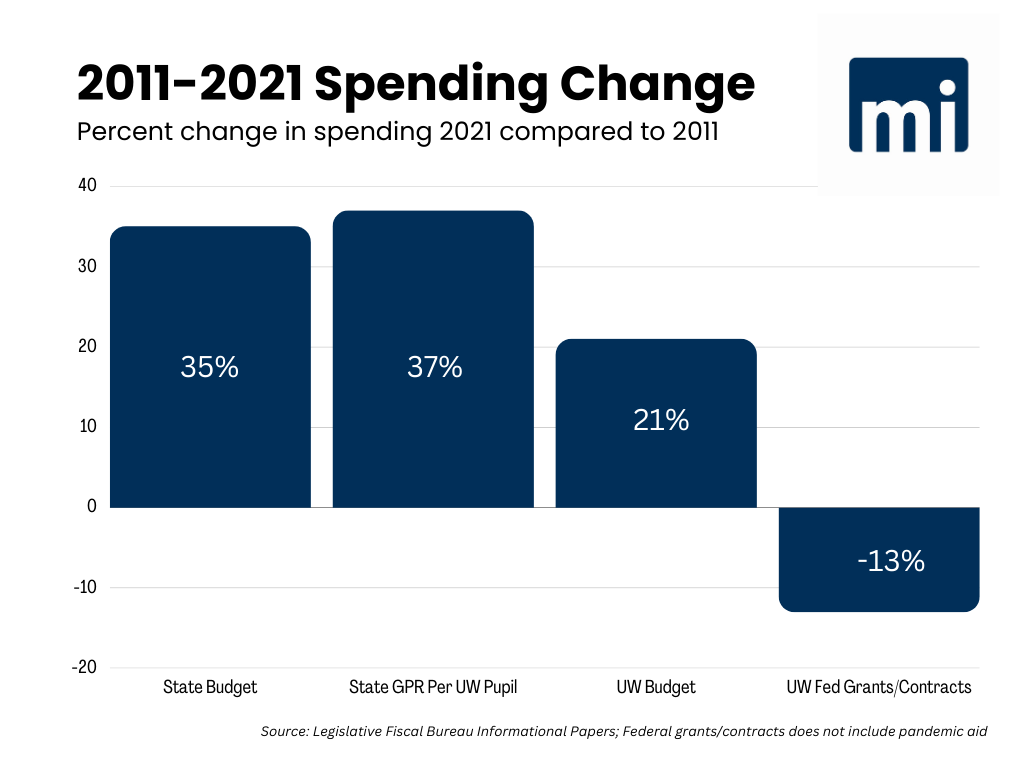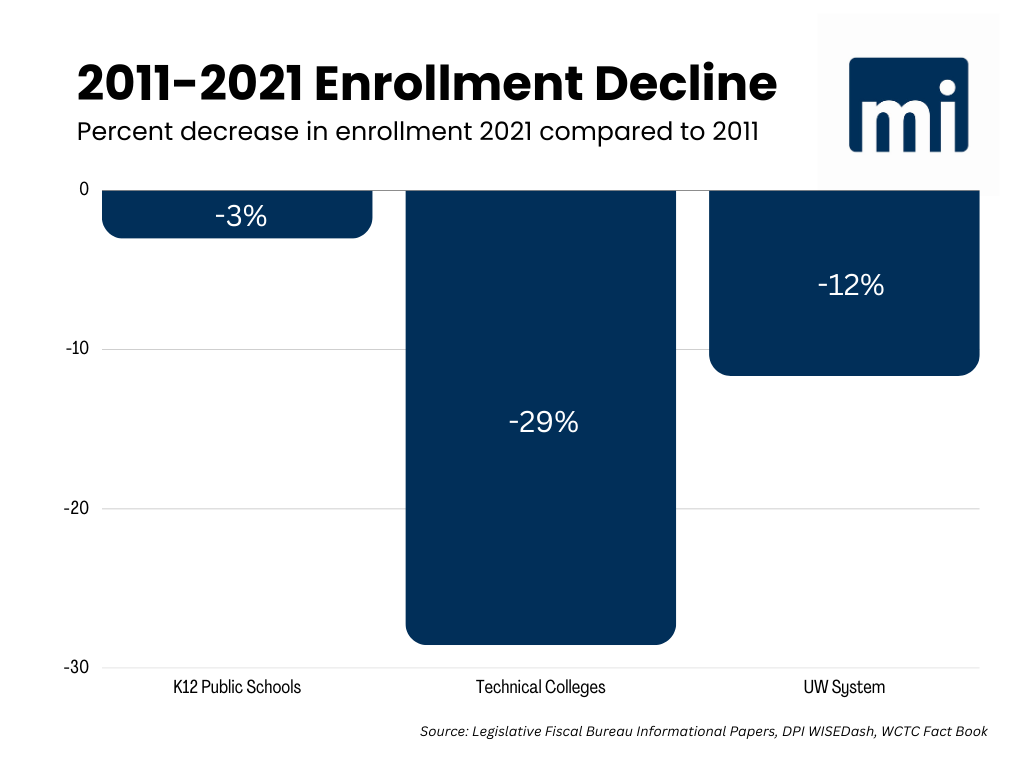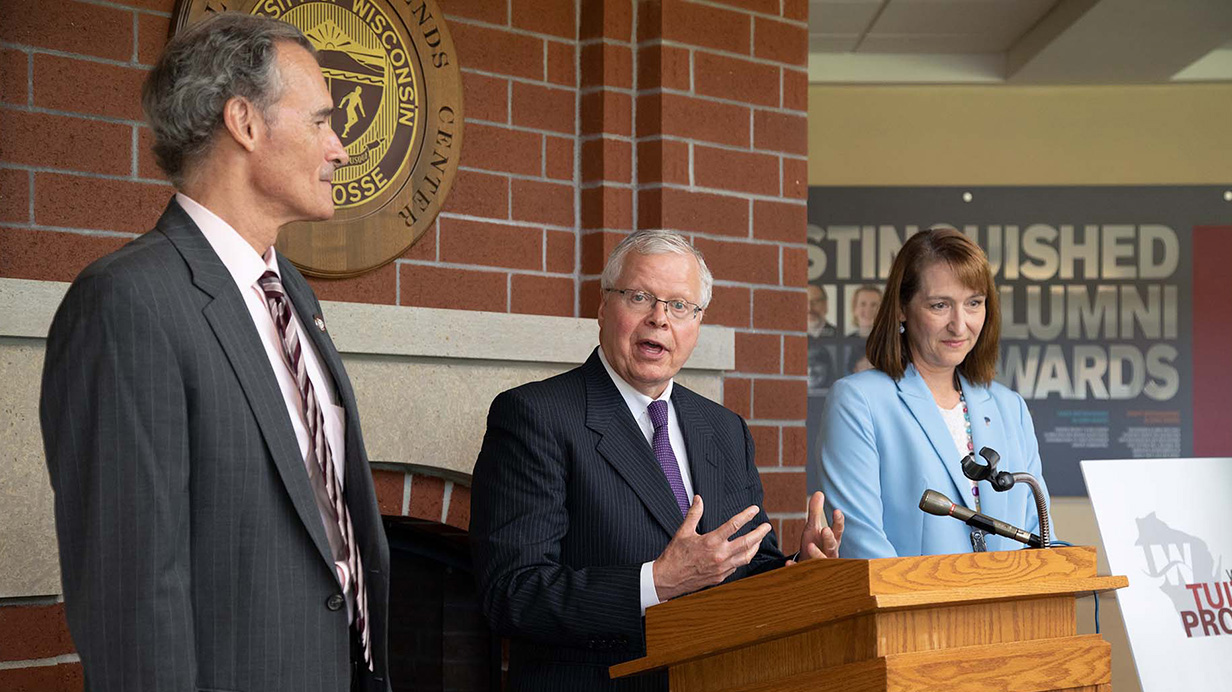
The University of Wisconsin system has been rolling out their lamentations in the forms of lists of draconian actions they’re going to have to take because legislative Republicans won’t give them the half-billion increase in funding they want. In recent weeks, we’ve seen stories about how campuses are spending more than they take in and are spending down reserves just to keep the doors open.
Is this the truth, or is there a little more to the story? A few hints:
The number of administrators in UW System increased 47% last year alone, while enrollment declined.
While the numbers of administrators increased, instructional faculty and staff have decreased.
Years of DEI focus has pushed down enrollment of white students so they are now underrepresented.
Unrestricted PR balances are higher than they were when the legislature uncovered the secret slush fund a decade ago.
Admissions changes have brought in more underprepared students and increased remediation expenses.
State GPR support per UW student has increased at a faster rate than state budget spending.
The three campuses looking at layoffs and furloughs all increased their administrative staffing over 50% while enrollments declined.
Henny Penny Rothman
UW System President Jay Rothman, warned during budget deliberations that 11 of 13 campuses are running a cumulative deficit of nearly $60 million and they were in desperate need of a large increase in state funds. This is the same guy who hired a new, cabinet-level Diversity, Equity and Inclusion VP in the middle of these same budget deliberations where he was begging for cash, when legislators had made it clear that DEI indoctrination spending was not on their priority list and they wanted to see DEI positions cut.
Rothman is just another in a long line of System leaders who make it their business to cry poverty and blame legislators – who they hold in clear contempt, though some are better at hiding it than others – for driving the institution into poverty and disrepute.
This year, the UW requested a $436 million increase in tax dollars; Governor Evers’ massive budget provided only $306 million more. The legislature kept funding steady, withholding $32 million that the UW is spending on a raft of Diversity, Equity, and Inclusion (DEI) staff, pending a report to the finance committee.
Rothman said that the UW was “consuming their reserves at an unsustainable rate,” running structural deficits by spending more than they take in. He blamed the legislature’s lack of “investment” of more state tax dollars, the tuition freeze and declining enrollment for being a perfect storm forcing academics to overspend.
Recently, UW-Oshkosh has announced layoffs/furloughs of potentially 20% of their staff. They say they don’t intend to cut faculty positions so as to “shield” students from impacts, but they have cut instructional staff over 5% in past years, while growing their administrative staff by a stunning 60%. UW-Platteville and UW-Parkside also have indicated layoffs may be in the offing.
State taxpayers fund 18% of the UW System, and tuition, much of that coming from Wisconsin students and families, funds another 24%. After years of building up fund reserves, the influx of over a half billion in federal pandemic funds, and decades of increases in administrative spending along with declining enrollment, it seems like they’re (again) playing Henny Penny.
But is the sky really falling this time on UW System because of the baddies in the legislature, or is there more to the story?
No surprise, there’s plenty more.
Administrative Bloat
The UW system has been called out for administrative bloat for decades. And it’s getting worse.
As we reported in 2010, a Goldwater Institute study on the unchecked growth of administration in American universities pointed out that UW Madison’s ratio of full-time administrators/100 students soared 32% between 1993 and 2007, while instructors and researchers increased by only 5%. At that time, Madison had 14 Administrators per 100 students, and only 7 teachers/researchers. Similarly, UW Milwaukee increased their administrator-student ratio by 2% during the same time period while decreasing instructional and research staff by 3%.
In 2019, even Wisconsin Public Radio mentioned the continuing expansion of administration while faculty numbers were shrinking. Between 2014 and 2017 faculty decreased by nearly 8% while administrators increased 3.5%. Madison decreased faculty 4% and increased administration 11%.
According to the National Center for Education Statistics, the number of administrators in US public colleges increased substantially between 2009 and 2021 but the number of faculty also increased 3%.
UW System is bucking that trend.
At UW System, spending on instruction is going down, not just because of declining enrollments, or declining federal aid, or frozen tuition, or the state not meeting the UW budget asks, but because the focus of the administration of the UW System is on more administration, not more education.
On their “Accountability Dashboard,” UW System characterized 5% of total expenditures as administrative in 2011; in 2021 it was up to 8%. In dollars, the spending increase was 78% on administration. Not surprising given they have over 21% more administrators in 2021 than 2011.
In just one year, between 2021 and 2022, the number of UW System administrators increased 47%. That’s on top of the 21% increase over the prior decade.
Meanwhile there has been a decrease of 5% of faculty, instructional staff, and graduate assistants during that same time period.
If the UW were truly financially struggling, they would cut some of their shockingly top-heavy administration costs. The $32 million being held pending UW submitting performance metrics represents the portion of the UWs budget that the 188 DEI employees cost the System. It’s a drop in the bucket of the massive administrative spending increases, but it’s a start.
Gaslighting on DEI
But cutting administration and staff that aren’t con that’s not on the UW agenda. Consider their throw-down over keeping 132 DEI administrative positions: While the legislature made it clear they did not support the positions they see as meant to indoctrinate students and manufacture inequities to be solved, Rothman hired a new, cabinet-level Vice President of Diversity, Equity and Inclusion in the middle of the budget process. He did try to keep the appointment on the DL, limiting who the announcement was sent to, but it quickly undermined his bargaining position with the legislature.
Rothman and System leaders claim DEI programs are important to cultivate a student body that reflects diverse backgrounds and provide greater enrollment opportunities for historically underrepresented groups. Some students claimed that opposition to DEI positions was an attack that puts campus communities across the state “at risk.”
UW-Madison Chancellor Jennifer Mnookin went even further when she lambasted the legislature, saying their suggested cuts to DEI harm the entire state, because employers want and expect students to have experience working with people from diverse backgrounds. Mnookin is suggesting that this is currently not the case within the UW system, and that if we don’t increase the diversity of the student body – even to Madison it seems – employers will not be able to hire quality workers.
So how far short of having diverse enough enrollment is UW System? Do we want the student body to match the racial and ethnic background of the state, so that employers can finally hire people who have gone to college with enough other students from appropriately ‘diverse’ backgrounds? How much work needs to be done so White students are no longer ‘overrepresented’ among the student body?
Mnookin is pretty new here so she might not know we passed that metric about 20 years ago.
In 2000, the non-Hispanic White population was 87.3% and UW enrollment of non-Hispanic Whites was 87.9%. It’s been falling ever since. In 2022, the population of non-Hispanic Whites in Wisconsin was 80.1% and UW enrollment of non-Hispanic Whites was only 72.9%. White students at UW System were underrepresented by 7.2% last year and the disparity is growing, year after year. In 2022, about 5,000 fewer White students enrolled in UW System schools while total enrollment dropped only about 3,000.
3 Decades of UW DEI
The precipitous decline in the percentage of the White student population is the result of decades of efforts by the Board of Regents to increase diversity and access.
In 1987 they adopted objectives to double the number of students of color over the next decade and to increase faculty of color by 75% in 5 years. They met the faculty goal but only increased the enrollment of students of color by 67%. Then in 1998, they started another 10-year follow-up plan for the next decade with a similar goal of increasing the number of high school students of color who enrolled through targeted programs and increased financial aid for needy students. There were more gains in enrollment of students of color – by 2001 the percentage of students of color enrolled in the UW System closely matched the non-white population of the state.
But in 2008, after two decades of resounding success at increasing enrollment of students of color so that they were overrepresented in the student body, the Regents adopted yet another diversity initiative, this one apparently perpetual, which focused on DEI and continued efforts to increase the number of students of color enrolled and employees who are persons of color.
Changes in Admissions Policies
Since 2000, the Regents have also changed admissions requirements, shifting away from merit-based criteria. In the early 2000s class rank was the primary determinant for admission with the Regents directing that Wisconsin High School graduates in the top quarter of their class be admitted somewhere in System. Now, campuses are directed to consider 3 criteria: academics (which includes trends in grades), ACT/SAT scores (which Regents suspended as a requirement in 2020), and “other” factors including things like socioeconomic disadvantage and being a member of a historically underrepresented racial or ethnic group.
The two charts below, from UW Systems Accountability Dashboard, show the effectiveness of their decades of work to increase the percentage of students of color, and reduce the percentage of white students.
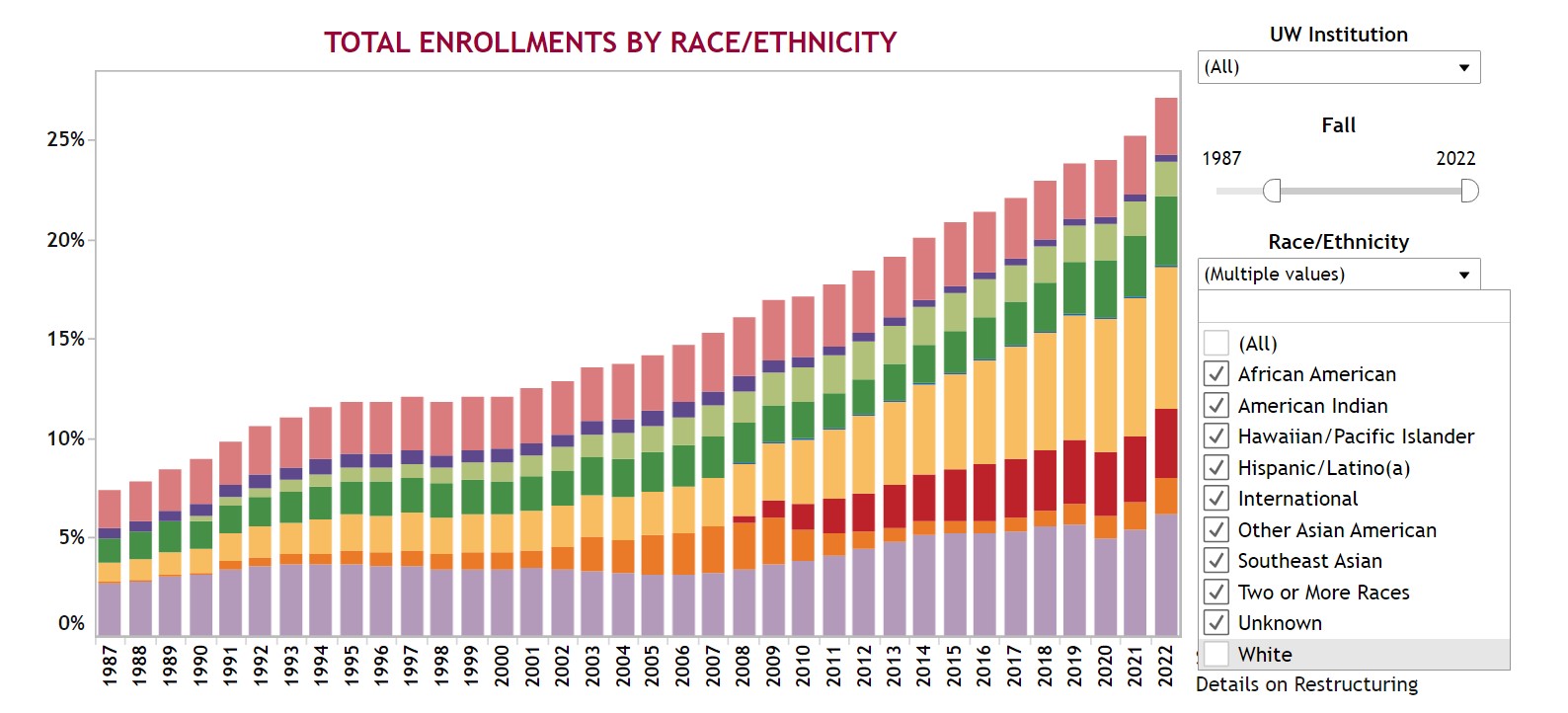
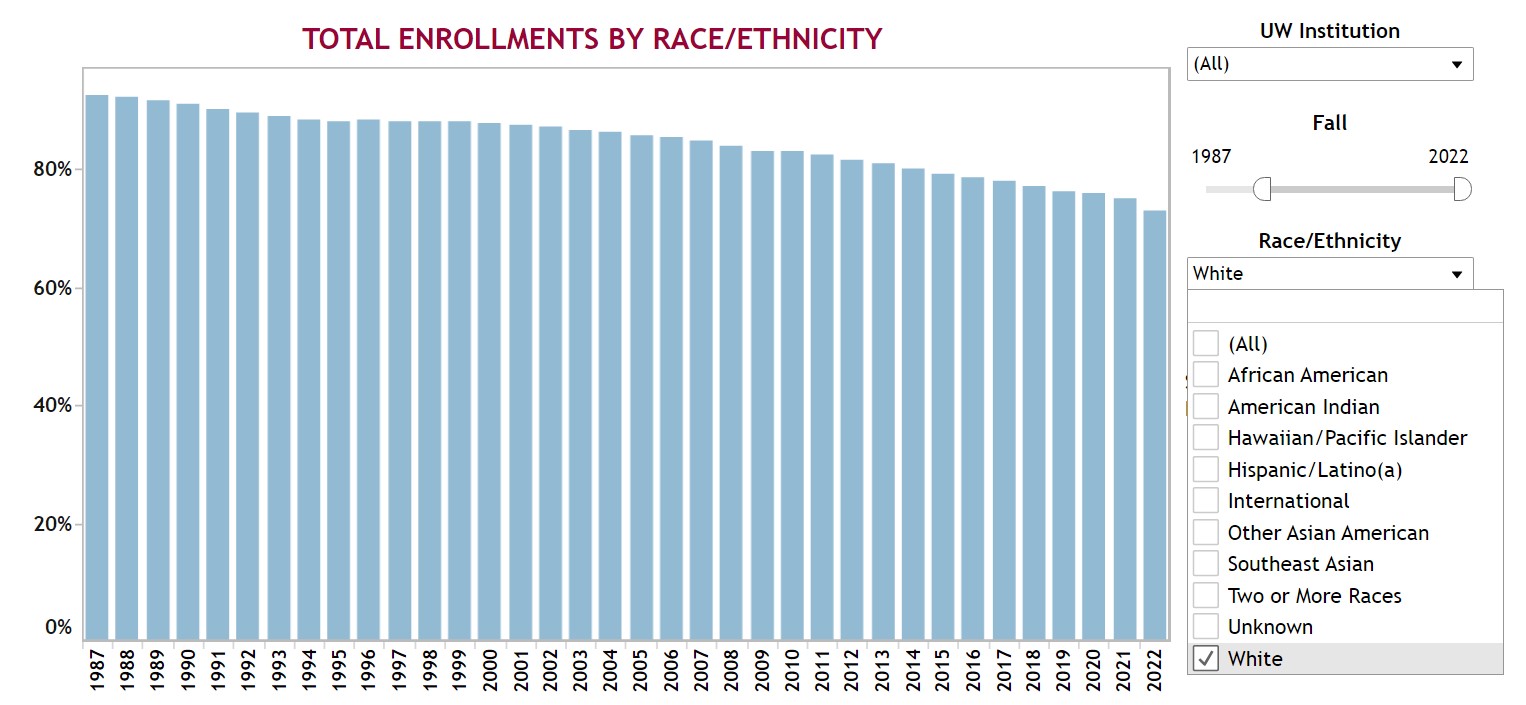
UW System has not been transparent about their preferred quota target goals for racial, ethnic, or other ‘diversity-based’ enrollments, so it’s impossible to guess what level of imbalance in the name of diversity will satisfy academia. It is clear the UW is looking for some unspecified further reduction of non-Hispanic White students even though they are already headed toward double-digit underrepresentation.
…And The Accompanying High Costs of Remediation
Wisconsin High School students have enrolled at UW increasingly in need of remediation over the years. It speaks volumes about the quality of education being provided in our K12 institutions, but it also speaks to the change in admissions policies. Between 2011 and 2013 more than 20% of freshmen needed math remediation; the number was 52% of students in the bottom quarter of their class (but still admitted to the UW); and 41% of those who were in the third quartile.
A 2018 report from UW System indicated that students with certain characteristics including “lower high school class rank and underrepresented minority students” tend to require remediation at higher rates.
Remedial education has been a problem in the UW System for years. But with changing admissions requirements and slipping K12 performance, the UW has taken on – and charges for – the huge undertaking of teaching college students basic material they should have learned in K12. The legislature required them to produce yearly reports on remediation in 2015.
Since then, UW System has stopped using the word remedial, instead calling the various programs, classes, and practices used to deal with students not able to perform at college level in basic courses ‘developmental,’ in the continuing academic mission to be less accurate. But offering remedial or even ‘developmental’ classes to cover high school (or lower) level material is expensive. Not just for the UW to provide, but for students and families.
At a time when the left has declared student loan debt a crisis and students don’t think they should have to pay back the money they borrowed for school, adding the cost of remedial classes adds even more expense. And the truth is that while remediation helps keep unprepared students in school longer, those taking remedial classes aren’t on the fast track to graduation – most aren’t on the track at all. For students of underrepresented minority groups who take a remedial class their first year, their 6-year graduation rate is only 38%. For students not in an underrepresented minority group the 6-year rate is just 53%.
Remediation is a way for the UW System to expand the pool of students they enroll, and students are a revenue stream. Ditching academic merit as the main admissions qualifier allows them to dip into a pool of far less prepared students. But many of those students do not manage to hold on to graduate, and are saddled with debt for a degree they struggled – and failed – to earn. But to UW, the only real downside of remediation is the huge cash outlay required for the many programs they have to create to teach high school material to so many students.
If the mission of the UW System were to educate top students for the workforce of today, and tomorrow – bloated administration, DEI, lower admission standards and remediation seem poor investments, especially if they are struggling to manage their multi-billion dollar budget.
So it’s clear the UW is not focused on wise expenditures, or even prioritizing their spending on education. But are their revenues in bad shape?
Remember The Secret Billion-Dollar UW Slush Fund?
Well, it’s bigger now.
Unrestricted Program Revenue (PR) balances, aka the ‘slush fund,’ consist in part of tuition payments and last year it topped $1.1 billion, increasing over 13% in just one year. This after the bru-ha-ha in 2013 when the legislature figured out there was a $1.05 billion slush fund during an earlier episode of the UW crying poverty as they pushed for more state funds.
The situation in 2013 was this: after years of tuition increases, continued requests for more state funding, and claims of poverty, the UW had built up a ‘secret’ slush fund of over a billion dollars in unrestricted funds. The UW eventually acknowledged their transparency was lacking, and in an attempt to force the spend-down of the cash, lawmakers froze tuition, and required regular audits.
Did the UW comply? They are regularly audited, but the slush fund balances are a tad higher now than they were in 2013.
It’s interesting to note that a smaller proportion of the slush fund is tuition dollars today. In 2013, $400 million fund was from tuition, this year it’s $300 million. It’s a substantial decrease but contextually, with a decade of frozen tuition, not nearly the decrease that would be expected. And according to the most recent audit, the decrease in tuition balances is primarily related to higher salary expenses. No doubt for all those new administrators.
In 2014, the ‘reserves’ portion of the unrestricted balance was 11.4%; now, it’s 10.6%. Not much has changed, except the slush fund is now old news, and the UW has successfully pivoted to claiming it’s racist not to give them the increases they demanded.
Another Thing UW Fails to Mention – Per Pupil Spending Increases
One thing you’ll never hear the UW mention in a positive way is the state funding per pupil. They may lament that Wisconsin spends less per pupil than other universities, many in far more expensive geographic regions. But they won’t ever say how much per pupil state spending has increased.
Yes, increased.
Since 2011, state support of the UW, in real dollars and tax dollars per student, has increased. At the same time federal grants and contracts decreased in real dollars and dollars per student.
Between 2011 and 2021 state tax support per student increased 37%, with overall GPR funding increasing 21%. The federal grant/contract support decreased by 13% overall and decreased per student 1.8%.
In context of the spend-a-thon legislators have gone on over the past decade, increasing state spending 35% in the 2021-23 budget over the 2011-13 budget, a 37% per pupil increase for UW – in that same time frame – paints a pretty positive picture of the state taxpayer’s commitment to the UW System.
UW Federal COVID Cash
The Legislative Audit Bureau looked at UW System use of $564 million in pandemic aids (which had to be used for costs incurred by June 2023) and as of June 2022 only $27 million was yet to be spent. These amounts do not include other pandemic funding the UW received, including $32 million for COVID testing and $5 million for mental health services.
While the UW claims that the COVID-cash wasn’t enough, the infusion of over a half-billion into their coffers over a three year period merits a mention too. And it’s important to note that none of the COVID dollars are included in the unrestricted PR funds.
Deficits, Layoffs, Furloughs
So let’s circle back to the 3 campuses, so far, that have announced their dire financial straits.
| Campus | Deficit | Unrestricted PR 2022 | Unrestricted PR Change 2021-22 | Administrator Increase 2012-22 | Instructional Faculty Change 2012-22 |
Enrollment Change 2012-21 |
| Parkside | $4 mil | $17.3 mil | 3.0% | 50% | 2.7% | -17% |
| Platteville | $9.7 mil | $28 mil | 12.9% | 54% | -22.4% | -25% |
| Oshkosh | $18 mil | $20.3 mil | -36.8% | 60% | -5.5% | -1.5% |
Each of these campuses has increased their administration staffing substantially, all have substantial unrestricted PR balances, and all have declining enrollment. Two have decreased their instructional staff during the same period.
Rothman said layoffs and furloughs are “missed opportunities” for students and families, blaming the legislature for not providing the nearly half-billion increase they asked for in their budget proposal. He didn’t address how decreases in enrollment coupled with massive increases in administration make fiscal sense. And he sure hasn’t talked about System’s missed opportunities to plan for declining enrollment or dial back administration.
It’s clear that the UW System has the tools to solve their spending problems, but they lack the ambition to do so. Their go-to play is always to blame others for their mismanagement. With so much administration sucking up so many resources, it’s surprising they can’t find someone qualified to help them get their fiscal house in order.
Declining Enrollment Will Continue to Drive Educational Finances
Like the UW, and public K12 schools, the Technical Colleges are seeing declining enrollment, but at a far faster rate. While there is a good argument to be made that the Technical Colleges are best positioned to fill the skilled workforce needs in the state, they are increasingly feeder schools for the 4-year campuses. With such precipitous drops in enrollment, this is clearly an area where policymakers should focus.
The missions of our educational systems are entangled, overlapping, and expensive. UW System teaches high school classes, Tech Colleges teach Basic Studies classes for 4-year colleges, High Schools are turning out kids who can’t perform at grade level, much less college, but they want to teach college level classes, and increasingly, they want to be health care providers for kids. This mission creep is costing taxpayers more, and it’s fairly clear that performance is not the better for it. Declining enrollment is going to continue to put increasing pressure on all institutions, especially higher education, and we can only expect to hear more pleas for funds in the coming years.
Policymakers would be wise to tie funding to excellence, demand academics are prioritized over administration, and push back against the UW’s latest lamentations.
